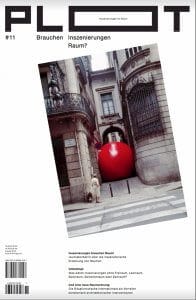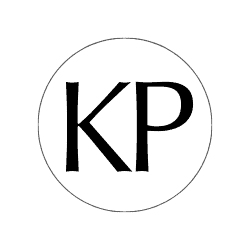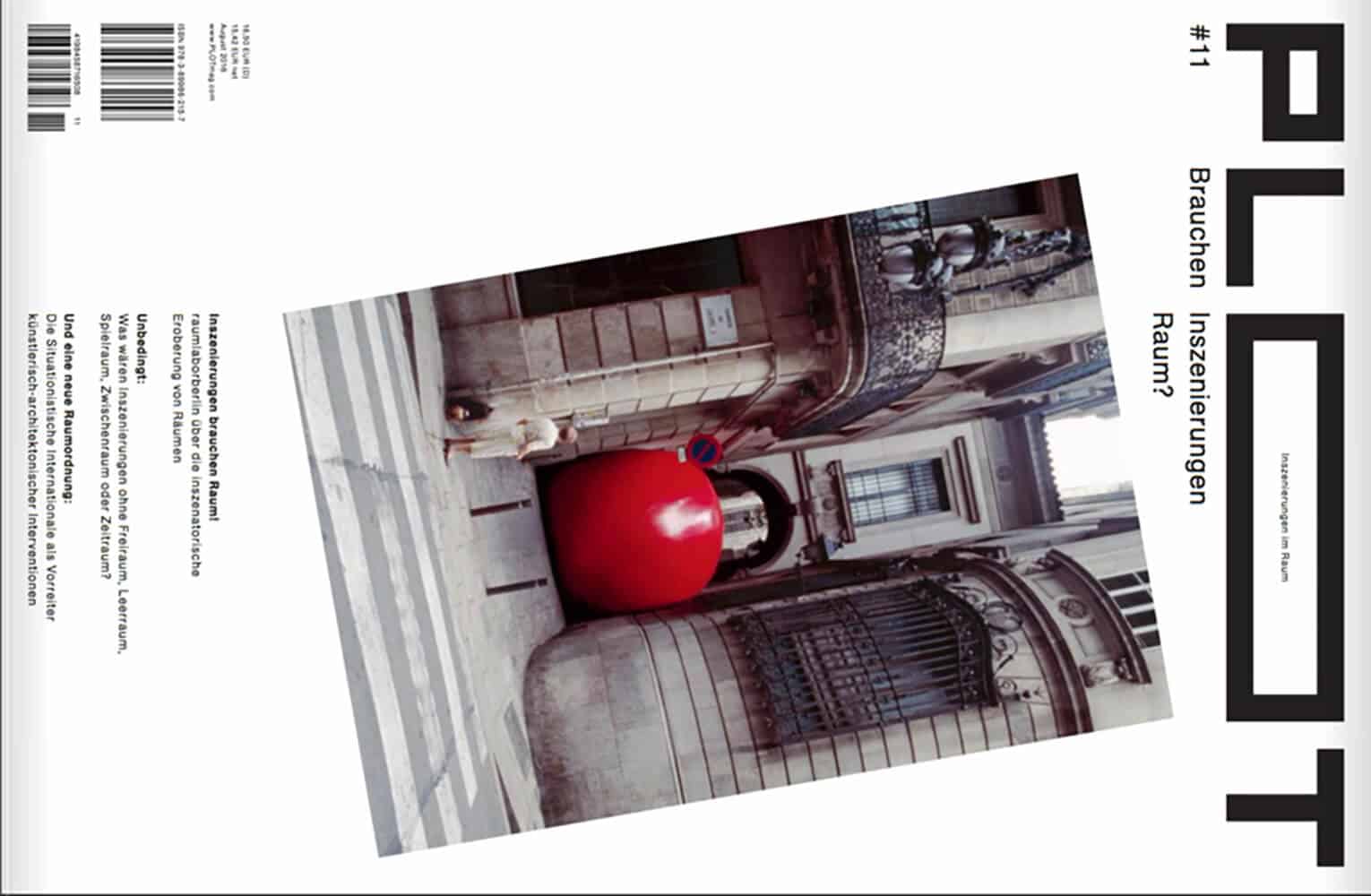My Interview with PLOT Magazine March, 2015 (session 1/2)
Kurt Perschke
Interviewer: Janina Poesch
Dipl.-Ing. (Architektur)
Stuttgart
PLOTmag.com
Published in Issue #11, 2016

How did the Red Ball Project come about? What inspired you?
Really it started with a specific site. I was offered an opportunity to develop an idea for one of three sites in St. Louis through the Arts in Transit program. I kept coming back to this ugly area underneath an overpass with a bit of gravel on the ground. It had clearly been offered up because it was one of those leftover spots in a city, but I was drawn to the way the concrete bridge merged into the earth and the space it created. RedBall came out of my thinking about that space, and how to show what I was seeing. Once I was on that path it was clear it needed to move, to play with sites over and over and build a conversation through iteration.
What does the “space between” mean for you?
I’m a sculptor and I see like a sculptor. Negative space & positive space/mass – they enable each other. Architects, designers, choreographers all have a version of this. There is a lot of theory around it, but for me I prefer to think of it on a bodily, perceptual level. RedBall is acting in place of the body as an occupier of space. When I work with a choreographer like Kate Weare for stage it comes up in a very different way, and I’ve learned if you want to take the smallest bit of the stage space away from a choreographer you have to fight for it! Stage design can be quite a fascinating challenge, and working with other artists in service of a larger performance is often liberating, to see your work taken and grown through the process. Of course I’m a visual artist not a trained theater professional, so I am always learning, most especially from the lighting designers who I work with.
Would you say that the Red Ball Project has evolved into a brand in its own right? Does that put you are somewhere between art and commerce?
Brand is one of those mercurial words, it can apply everywhere but it will mean different things in different cultures. In the US, when you say an artist has a ‘brand’ it’s understood that it’s not about commerce but about identity.
But the real meat of your question is “art and commerce.“ Actually, I think it’s a disservice to artists to propagate the myth they are opposites on a scale – why would that be? Like other professionals, contemporary artists can navigate the commerce of the art world and protect the integrity of their creativity. I have a personal desire for more artists to feel empowered to escape this destructive and outdated myth. I’m very grateful that touring a project like RedBall has taught me many things over the years and one of them is that I can work with a much larger, global set of presenters, funders, etc. than just those within art world, reach a larger audience, and still create my work the way I need to.
Have you already used the Red Ball Project to advertise yourself (or your work)?
Well, the project is my work. Successful ideas advertise themselves.
Do you feel that Shell adopted your idea to use it as an advertising campaign? What is the story behind that? Has that happened before?
Yes, it’s happened before, and probably will again. It’s upsetting but once I understood how advertising agencies work, not surprising. They use Google image search for research, and a picture of my work goes up on an idea board. That’s probably what happened with Shell. The smart agencies just call me, and that has lead to some really great projects for everyone involved like Paris with Bacardi-Martini which originated with an event agency. Other times, people don’t realize the rights that artists have or that they will defend them, as I have. When the Shell campaign confused major curators and writers I had worked with, many of them contacted me to inquire about the ads and I knew I had to act, that led to the piece in the Guardian by Mark Brown. It looks like we will reach an ‘mutually agreed settlement’ that respects my rights, and that Shell campaign will cease worldwide. For me that is a win. (artist note, the outcome is discussed more in the second section which took place after the settlement)
Would you allow a brand to use your ideas?
RedBall does not endorse brands, but it can partner with them. But I’d like to unpack this a bit because it touches on something very important today. If an artist does a project for a museum, and the museum uses it to promote themselves, is that a “brand using an idea?” I’d say yes. Every museum in the world is a brand and does this in their marketing. If you replace the word ‘brand’ with the word ‘museum’ or ‘collector,’ does it change your perception? If your in the art world it does, but that needs to be brought into the light.
Creative ideas have value. If an artist translates that impulse into paintings or sculpture or performance and sell them they are supporting their practice organically though their own creativity. Artists are often crippled because they have been taught that they need to be sheltered from this process. As an artist friend succinctly said to me recently “museums launder money for artists“. Every museum in the US actively seeks corporate support, soon this will be true in Europe if it is not already. Old lines are blurring. Yet if an artist takes that very same funding directly it’s seen as dangerous to their reputation. Who is served by that perception?
True story: a documentary filmmaker friend was recently told by the Sundance Institute that her doc film was ineligible for submission because some of the funding was from a company, a ‘brand.’ Amazingly, it was a ‘brand’ that Sundance itself takes ‘corporate support’ from. So it was OK for them but not the artist they serve. You see many parallels to this in the art world.
Interview with PLOT Magazine January, 2016 (session 2/2)
Janina: In general the phenomena exists, that people loose the “connection” to several places – not just the inhabitants, also the municipality “allows” that several spots get in a bad state and neglected. In Germany we use for this phenomenon the term “Unorte” and in a broader approach – and less judgemental – we talk about “Leerraum” – roughly translated as “non-places” and “empty space”.
1. Can you give a personal description and definition of this terms?
Well it sounds like “Leerraum” or “non-places” is actually were RedBall started, the very first site was like that. It’s why perhaps the permissions were already in place, the smoothest administrative path.
2. Do you reflect in your work on such phenomenas in public space?
For me yes these kind of sites are a special pleasure when I get the chance for them within a suite of sites. I think many artists are drawn to these unorte or leerraum places, I wonder if it’s the implied freedom of them or some common bent towards the lesser seen spot. Of course this artistic bias can become it’s own trap.
For example if I were to do a city with RedBall and ONLY do lost places and rough patches, someone might frame that as a greater artistic expression, but it’s not. As as performance, I must gather the audience before I bring them to something possibly uncomfortable. A stage actor knows this rhythm. Also with the art world’s current bias, I sometimes wonder if a tourist site has ironically become the more radical choice. Either way I need to look at the possibilities clearly and build a performance for the audience, not for myself.
3. Can the Red Ball Project been understood as something that fills such a non-place? Physically and also “mentally/spiritually”?
In the sense of formalist ‘negative space’ of course this is it’s game. As a narrative, yes the way an eye might move over a painting I move attention over a city, and in many ways that is the medium of the project. Bringing peoples energy to a specific spot in the city for a collective moment, the ball becomes a theatrical prop from this perspective, a magnetic force.
4. In interviews you often talk about the wish that the Red Ball Project “opens a doorway to imagine what if?” – can you describe more pictorially what you mean by that?
You can’t experience the piece and not later at some point think, “oh, that would be a good place!”. So it become a lens to look at the built environment. It’s not a permanent shift, but it’s an experiential one, and an element of the work.
5. In Cologne we’ve got the project “Blick heben” (direct translation: “lifting your point of view” / https://www.blick-heben.de/idee/ ) – the project is about rediscovering the built environment and focussing your point of view on small details in space by just writing the words “Blick heben” on the floor. Do you understand the “rediscovery” of spaces and specials spots as an essential part of the Red Ball Project as well?
This is a concept that many public urban works spring from. However for me I’m not really doing a tour of lost corners. It can be just as joyful to have a fresh experience with a place that you might walk by everyday. I see this pattern a lot on tours, magnificent spaces become invisible to locals because they are static and familiar. This is where RedBall breaks from work that only wants to consider the lost places, and why being an outsider can have advantages.
6. Is the Red Ball Project more about the space? Or more about the user of the space?
It’s about the experience of the audience on the day of the performance. That can be driven by the site, but the work lives through an audience.
7. What is the most fascinating aspect about the Red Ball Project?
ah! well I’ll have to write a book for that one..
8. Do you have a personal memory/situation/meeting concerning the RedBall Project that reflects the whole idea?
a story? not sure ‘one to fit it all’ but lets talk on skype.
9. What german city would be interesting for the RedBall Project?
This question is better answered by you, or the reader. Because while certain qualities do help (pedestrian downtowns, architectural variety, a willing audience) my role is to find the expression of the city. Germany is vast, Cologne, Munich, Leipzig, Berlin, Hamburg, and on; all yield different opportunities and RedBall would reflect this, not just in sites but in audience. This is a fascinating part of the journey, audiences really to change country to country and city to city.
10. You describe that you are doing on-site research – do you do profound research concerning architectural history or general history of the city before exploring the space? Or is it sometimes also a situational decision by exploring the several parts of the city where you display the art?
Their is always research, but I have done it different ways actually. I have done months of reading on a cities history before flying out. It enriched my experience in the city, but the process of finding sites didn’t change. Their are always logistical hurdles, some are overcome some not. Some of the most memorable sites to me personally are the ones I didn’t get to do, I feel the loss of them. This is part of the practice that moves from the fine arts to the performing arts. In the fine arts the goal is to bend everything possible (material,time,space) to realizing the concept of the work, performing artists for the most part expect to work within confines of time (performance) or space (theater). If the city is my theater, I can tell you she is not always kind!
11. You refer to Christopher Alexanders’ work “pattern language” – how does it influence your work and especially the work of the RedBall Project?
It’s not so much an a-b influence. It’s more like I’ve spent over a decade learning how to read the psychology of a city, and one day I opened a book and there was what I had been learning, laid out in 253 patterns. It was confirmation and expansion. The way we inhabit spaces, how we feel in them, how the sun moves us like a flock of birds from one place to another. If your going to work in public space with an audience, you need to learn the psychology of space, it’s never just ‘empty space’.
12. What is your current mood about the shell-debate? What is the actual situation?
My representation got in touch with Shell, their was a worldwide takedown of the campaign, the rest I really can’t go into details except to say we reached an agreement that I feel respects my copyright.
As for my mood I will say that I actually want to find a way to communicate with other artists about the experiences I’ve had. Especially in the visual arts everyone is a soloist and not enough is shared. After two international suits, I’ve learned many things about what really is possible in protecting your work, some of it the hard way. While specifics might change country to country, the artists I know tend to be cautious when they could be bold, though also sometimes unrealistic about the legal process. It’s just a matter of a platform to share experience to create more empowered artists. I hope I find a way in the future.
( my note: this desire is the reason for launching The Project Artist site )
[wd_hustle id=”in-line-opt-in—general-contact”]

